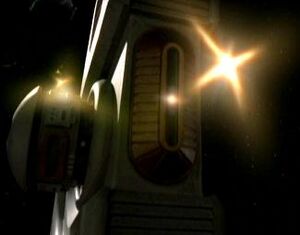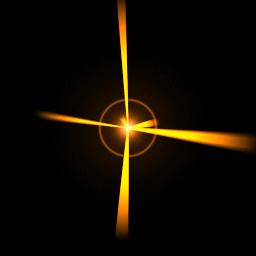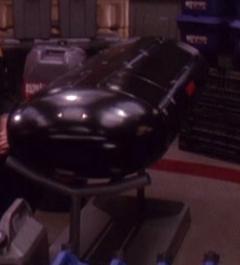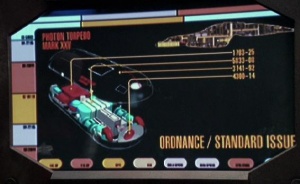Photon Torpedo: Difference between revisions
No edit summary |
No edit summary |
||
| Line 1: | Line 1: | ||
[[Image:photon_torpedo.jpg|thumb|right|A fired Photon Torpedo.]] | [[Image:photon_torpedo.jpg|thumb|right|A fired Photon Torpedo.]] | ||
[[Image:Photon torpedo - the ship.jpg|thumb|A standard Starfleet issue photon torpedo]] | [[Image:Photon torpedo - the ship.jpg|thumb|A standard Starfleet issue photon torpedo]] | ||
[[Image:Mark XXV torpedo interior.jpg|thumb|A schematic of a Mark XXV torpedo]] | [[Image:Mark XXV torpedo interior.jpg|thumb|A schematic of a Mark XXV torpedo]] | ||
A '''photon torpedo''' (sometimes called '''photon''') is a projectile weapon commonly used by | A '''photon torpedo''' (sometimes called '''photon''') is a projectile weapon commonly used by Starfleet starships and starbases in the 23rd and 24th centuries. Its predecessor was the photonic torpedo. Its successor was the quantum torpedo. | ||
==Overview== | ==Overview== | ||
A photon torpedo utilizes a warhead of | A photon torpedo utilizes a warhead of matter and antimatter which produce a destructive explosion when combined. 24th century photon torpedoes are equipped with navigational sensors to seek and track its targets, as well as a remote self-destruct system. A Starfleet torpedo shares the same oblong casing as a Class-8 probe. | ||
Launching photon torpedoes at short-range targets is noted to be somewhat dangerous, since the explosion can also damage the firing ship as well, and is an almost unheard-of occurrence. The | Launching photon torpedoes at short-range targets is noted to be somewhat dangerous, since the explosion can also damage the firing ship as well, and is an almost unheard-of occurrence. The USS Enterprise-D escaped damage after attacking a pursuing Borg cube in 2365 and later in 2367 when an aggressive Cytherian probe prompted the same action. | ||
Photon torpedoes appear as red, orange, yellow or blue blobs of light when fired. While technically antiquated by the invention of the [[quantum torpedo]] in | Photon torpedoes appear as red, orange, yellow or blue blobs of light when fired. While technically antiquated by the invention of the [[quantum torpedo]] in 2368, photon torpedoes remain a crucial part of [[Starfleet]]'s arsenal, at least until the fabrication process for quantum torpedoes is streamlined. | ||
==Tactical== | ==Tactical== | ||
[[Image:Battle ds9 station.jpg|thumb|''[[Deep Space 9]]'' firing photon torpedo volleys from torpedo turrets]] | [[Image:Battle ds9 station.jpg|thumb|''[[Deep Space 9]]'' firing photon torpedo volleys from torpedo turrets]] | ||
The Mark VI photon torpedo has a maximum explosive yield of 200 | The Mark VI photon torpedo has a maximum explosive yield of 200 isotons, but even earlier models were capable of substantial destruction. An unshielded ship (for example, the Miranda class, USS Lantree could be obliterated with a single hit. | ||
Torpedoes can also be programmed to fire in a set dispersal pattern when brute force would not provide optimal results. By attacking multiple key systems on an enemy vessel at once, the overall damage can possibly be increased. The Enterprise-D was able to destroy a Klingon K'vort class battle cruiser in an alternate timeline with only one volley and follow-up phaser fire. | |||
Despite the danger of a close-range explosion damaging the firing ship, a Starfleet crew's inherent knowledge of the weapon's design means that it is possible to modify the shields to protect the ship from the torpedo's impact. | |||
Revision as of 04:50, 24 June 2006
A photon torpedo (sometimes called photon) is a projectile weapon commonly used by Starfleet starships and starbases in the 23rd and 24th centuries. Its predecessor was the photonic torpedo. Its successor was the quantum torpedo.
Overview
A photon torpedo utilizes a warhead of matter and antimatter which produce a destructive explosion when combined. 24th century photon torpedoes are equipped with navigational sensors to seek and track its targets, as well as a remote self-destruct system. A Starfleet torpedo shares the same oblong casing as a Class-8 probe.
Launching photon torpedoes at short-range targets is noted to be somewhat dangerous, since the explosion can also damage the firing ship as well, and is an almost unheard-of occurrence. The USS Enterprise-D escaped damage after attacking a pursuing Borg cube in 2365 and later in 2367 when an aggressive Cytherian probe prompted the same action.
Photon torpedoes appear as red, orange, yellow or blue blobs of light when fired. While technically antiquated by the invention of the quantum torpedo in 2368, photon torpedoes remain a crucial part of Starfleet's arsenal, at least until the fabrication process for quantum torpedoes is streamlined.
Tactical

The Mark VI photon torpedo has a maximum explosive yield of 200 isotons, but even earlier models were capable of substantial destruction. An unshielded ship (for example, the Miranda class, USS Lantree could be obliterated with a single hit.
Torpedoes can also be programmed to fire in a set dispersal pattern when brute force would not provide optimal results. By attacking multiple key systems on an enemy vessel at once, the overall damage can possibly be increased. The Enterprise-D was able to destroy a Klingon K'vort class battle cruiser in an alternate timeline with only one volley and follow-up phaser fire.
Despite the danger of a close-range explosion damaging the firing ship, a Starfleet crew's inherent knowledge of the weapon's design means that it is possible to modify the shields to protect the ship from the torpedo's impact.


